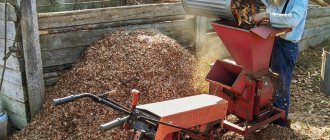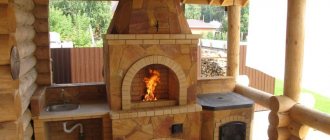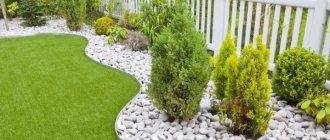Every year, garbage accumulates on the site, which has to be removed or burned. But there is a way to utilize branches, tops and grass for good. With the help of a garden shredder, plant waste can be processed into a valuable mass, which can then be used to fertilize or fill a compost pit.
In order not to get confused in the variety of models, the cost of which varies significantly, and whose technical characteristics make even an experienced gardener think, we have compiled a rating of garden shredders with the best reviews. We’ve also made a selection of useful tips that will help you decide on the optimal model for your site.
What kind of device, scope of purpose
As soon as the first rays of the spring sun warm the earth, gardeners go out to fight excess vegetation on their site, which interferes with the development of useful crops.
But weeding, thinning, and cleaning dry leaves and grass ends up cluttering the area with garbage, which not only spoils the appearance of the landscape design, but can also cause numerous plant diseases.
What to do in such a situation? Leaving garbage is unacceptable, and burning it is a risky business due to the introduction of a ban on burning grass within city limits according to the new Russian legislation.
It is unprofitable to remove garbage at your own expense, and it is a pity to lose raw materials for such valuable compost. And here a unit such as a chopper becomes simply irreplaceable, which will simultaneously solve all problematic issues.
A garden grass shredder is a new word in agricultural technology that makes it much easier to work on a plot of land and forget about the headache of getting rid of unnecessary grass. Representing a container with a number of blades and a powerful motor, this unit is capable of grinding any herb in a matter of seconds.
Weeds, thorns, dead wood, leaves and other debris are processed into fine compost, which no longer takes up much space, but is stored for further use as fertilizer for garden beds.
If you do not need to fertilize the site, it will not be difficult to pack excess compost into bags and remove it from your territory, which was simply impossible with those piles of plant debris that were weeds before processing.
If wood chips are processed, they are often used as fuel. Wood chips, processed through a grinder, are formed into pellets and become an excellent type of heating fuel, replacing firewood and coal. If you wish, you can form pellets at home.
Thus, there are many advantages from purchasing a shredder, which is why it has gained worldwide popularity and is becoming increasingly in demand in our country, not only in large farms, but also in private landholdings.
Tips for making a grass cutter
The magazine “Constructor” very often publishes tips on making various types of grass cutters, feed cutters and straw cutters. Along with the tips, drawings and assembly diagrams of various parts and components are also published.
Most grass cutters work like a food processor: the grass is chopped in a container with cutting blades. This explains the simplicity and lightness of the device.
But to make your own grass cutter made from any materials more functional, you can do the following:
- Sharpen only one side of the knives if you plan to chop plant branches,
- If you plan to use the grass cutter as a feed crusher, the blades need to be sharpened on both sides.
- To chop only herbs, use only diamond-shaped knives,
- Replace conventional fastenings with metal frames - this will increase the strength of the device,
- Cover the outside of the grass cutter with a sheet of metal. This will not only reduce the risk of injury, but will also protect the device from dust getting inside.
Device
At the moment, there is a wide variation in the choice of shredder models, but despite this, their design principle is similar, the difference lies only in the size of the device and optional features.
A standard shredder has the following structure:
- Metal body. An important condition for a shredder is its reliability and durability, and therefore heavy-duty metals are used for its manufacture. Polymers can also be used to produce the body of the unit. Often the body is mounted on a frame equipped with wheels. This is done to make it easier to move the device around the land plot.
- The heart of a shredder is its motor. This can be an internal combustion engine or an electric motor.
- The grinding process is carried out through a cutting mechanism powered by a drive.
- To make loading grass and leaves a simple matter, the unit is equipped with a loading bowl or, as it is also called, a loading hopper. As a rule, the bowl has the shape of a funnel, which makes it much easier to load plant debris into the shredder.
- The device also has a receiving hopper where the processed plant mixture is supplied. You can attach the bag to the receiving hopper, so you don’t have to waste time on arranging the mixture, or you can directly throw the mixture away during processing in the areas of your garden you need. There are models that allow you to adjust the direction and height of spreading the crushed mixture, which is also very convenient and saves time on gardening work.
Homemade grass cutters
Making your own herb grinder is not that difficult. Homemade products are in no way inferior to their store-bought counterparts, and the advantage is that the homemade device will be more economical and easy to maintain.
Sechkarnya
The simplest version of a homemade shredder is a chopper, which can chop grass and branches in a small volume. The cutting part is a plate made of durable steel, made in the shape of a triangle with a pointed lower edge. The steel plate is placed on a long wooden handle. The tool is ready to use. It is recommended to cut grass on a hard and metal surface, otherwise the cutting edge will quickly become dull.
A chopper for freshly cut grass can also be made from an angle grinder or washing machine, drill and many other available tools.
Drill grass cutter
A device for chopping grass can also be made from a conventional drill operating in two modes. In addition to the drill, you need knives and a shaft, bearings, a grass container and a stool. First, you need to drill a hole in the stool with a diameter of 1.2 centimeters. A frame with a bearing is attached below the hole. A hole is also made in the bottom of the bucket, after which it is attached to the stool with self-tapping screws. A shaft with a knife or cutting disk is placed on the bearing. The drill is installed from below so that the chuck is connected to the shaft tail. The grass is placed in a bucket and the drill is turned on.
Grass cutter from a grinder
A grinder is an indispensable tool available in every farmstead, from which it is easy to make a manual grass cutter. In addition to the grinder, you need:
- Bolts, nuts and metal brackets,
- Motor,
- Shaft,
- Cutting knives or discs,
- Net,
- Container for already cut grass,
- Frame,
- Pulleys,
- Screwdriver and hammer.
To make a grass cutter, you need to attach the engine with the shaft and box to the frame. A homemade grass cutter made from a grinder will use a motor from the saw itself, which will transmit voltage to the shaft. Knives or discs are attached to the rotating shaft. You can use blender blades. A box is also attached to the frame in which the grinding takes place. It can be metal or wooden, and another one is installed under it, for already chopped grass. The bottom of the box is made of mesh, through which the chopped grass will be sifted.
Grass cutter from washing machine
From a washing machine you can make a universal device that can be used both as a grain crusher and as a grass cutter. Before making the device, you need to make two sharp knives. Their size should be smaller than the diameter of the machine drum. Using bolts, a second engine is mounted under the cover of the machine. One of the knives is mounted above the washing machine motor, and the second is mounted on the additional motor. An important point is that the knives must rotate in different directions. To fill the material, a hole with a funnel is made in the lid. Remove the drain hose from the washing machine, enlarge the hole, and place a box under it. The already chopped grass will spill out through this hole.
There are no standard drawings for such a grass cutter, since washing machines have many varieties and features.
The second version of the grass cutter involves using only the body of the washing machine. A hole is drilled at the bottom of the body, under which containers for chopped grass are placed. The engine is secured inside the housing with special clamps. A bushing with blades is bolted to the engine - the device is ready for use.
Grass cutter from a vacuum cleaner
You can also make a grass cutter from a Typhoon vacuum cleaner. It is convenient in that it allows you to feed raw materials through the top hole, and the already cut grass will pour out through the bottom hole. If you don’t have a vacuum cleaner housing, you can use a piece of pipe and a motor with a power of about 180 W, as well as a sleeve, knives and a profile. To install the shaft, two holes are drilled on the sleeve. A motor is attached to the body, on which a shaft with knives mounted on it is placed. It is advisable that the knives be sharpened on both sides.
Types of engines, pros and cons
Shredders come complete with either an internal combustion engine or an electric motor. Both options have their own operating nuances, advantages and disadvantages. Let's look at this issue.
Electric motor
More often used for oversized units for home use, whose power does not exceed 2.6 kW. For a dacha or a compact garden not exceeding 6-7 acres in area, this is a completely acceptable option that will cope with the task assigned to it in eliminating plant waste.
The undeniable advantage of such devices is their lightness: it will not be difficult to move the unit around the site and power it from the mains. In addition, electrical devices are easy to operate and do not require special skills. Maintenance is also reduced to a minimum. But in the conditions of large farms or greenhouses, a shredder with an electric drive will no longer be functional.
In addition, the device is dependent on the power supply, which becomes somewhat problematic when working in large areas - you will need an extension cord, and this will limit the user’s freedom of action. Along with this, there are weather restrictions when working with an electric shredder due to the danger of electric shock: the unit cannot be operated in rain or high humidity.
Chopper with petrol engine
This is the most rational choice for “field” conditions, when there is no possibility of power supply from the mains, and the amount of work significantly exceeds the standard six hundred square meters of the average dacha.
Devices equipped with a gasoline power unit attract attention with their autonomy and unpretentiousness.
Most often, a two-stroke motor is installed on a device of this type, which is distinguished by its reliability, durability and increased power.
So processing tons of grass from the field will no longer be the limit of fantasy, but a very real task that your shredder will be able to do.
But the disadvantages include the fact that when working with a gasoline shredder, you must have basic skills in its operation. In addition, you will have to regularly check the condition of air and gasoline filters, spark plugs and carry out technical work. Although, if you wish, you can learn all this quickly enough.
Diesel shredders
As a rule, diesel engines come complete with professional-level equipment. The advantage of this type of unit is its high operating power: the chopper can operate without failures or shutdowns for many hours.
In addition, a positive point is the ability of diesel units to operate at low speeds.
But, like any unit, the diesel option also has its negative sides: firstly, it is a higher price compared to the two options listed above. Secondly, diesel models are large, and therefore are extremely rarely used in households.
It is extremely difficult to transport a diesel model on your own, so this is an excellent option for large farms, but not for private use.
If you still want to purchase a diesel model because of its high performance characteristics, you can turn your attention to equipping it with a mobile unit equipped with a high-power three-phase electric motor. In this case, it will be possible to move the unit around the site, which means its use will become more rational in the conditions of private land ownership.
DIY herb grinder
To be honest, I didn’t expect that the photo posted in the comments would cause so many responses.
But, since the idea of publishing the process of making a grass cutter had been brewing for a long time, I decided to do it. Let me start with the fact that the desire to make such a unit was inspired by the publication of our Vera Tukaeva, for which special thanks to her. After thinking about it, I reviewed the available materials and it turned out that there was practically no need to buy anything. I wandered through Internet resources, mainly on Forumhouse, looked at a couple of interesting homemade designs, thought about it, and decided to take it on.
Materials used:
Materials
- Metal corner 25x25 mm, used
- Steel sheet, 4 mm thick, used
- Steel strip 40x4 mm, used
- Tank from an old washing machine, body material: 2 mm thick duralumin
- Electric motor 1.2-1.6 kW (I don’t know the exact rating, the tag is worn out), 2750 rpm, previously used it on a cutting machine.
- Starting capacitors of different capacities, with an operating voltage of 400 V
Ads by
Tools
- Welding inverter, 160 A
- Angle grinder (grinder), used two at once, one for cutting metal, the other for stripping (so as not to bother with replacing disks during work)
- Cutting, grinding, flap discs, diameter 125 mm
- Electric drill
Manufacturing
First, I cut out a base for the frame from a corner, cleaned the metal of old paint and rust, and welded the base.
I cut the blank from a steel sheet, cleaned it, and moved on to the blank from the strip of the grass cutter body holder.
First, I cleaned the steel strip and bent the rough blank into a ring shape, with a diameter close to the diameter of the tank. Then he placed the tank on the base sheet, outlined the diameter with chalk and began to tack the strip with electric welding, gradually bending it to the required diameter. Then I boiled everything around the perimeter.
Blank - base
From scraps of a 60x60 mm corner, I bent L-shaped brackets for mounting the electric motor and welded them on the back side of the base.
Brackets
I secured the drive motor to the brackets.
Electric motor
Welded the base to the frame.
In the front part of the base leaf, I made a cut 1.5 mm deep, and folded part of the leaf down to release plant debris. I immediately ask welding connoisseurs to refrain from criticizing the quality of welds: they have never turned out beautiful for me, since I weld only when necessary.
Since my motor is three-phase, and the power supply to the site is single-phase, 220 V, I had to assemble a block of working capacitors (I picked up a soldering iron and remembered my pioneering skills). The capacitors were of different types; the selection criterion was an operating voltage of at least 400 V. In total, the total capacitance was 70 mF.
Block of working capacitors I placed everything in an old box from magnetic starters. In the future, when the issue of switching the power supply to 380 V is resolved (and it is being resolved), there will be no need for capacitors. As an option, use an old electric motor from a Rebir electric saw, it has a power of 2.2 kW, 220 V.
From a sheet of duralumin 2 mm thick I made a side cover for attaching the block, as well as a bracket for the start switch.
Side walls I attached the electric motor and the button, I had to buy a three-phase push-button switch of the VKN type, I tested it at idle, and started making the cutting and grinding part.
Knife blanks were cut out from an old two-handed saw (who remembers - Friendship 2), holes for mounting on a shaft with a diameter of 30 mm had to be cut out by electric welding according to a template made of textolite. I brought it to the required diameter with this equipment using an electric drill.
Blanks for knives
There was already an attachment on the shaft for attaching knives, since the engine was previously used as the basis for a sharpening and cutting machine.
Initially I planned to use this version of the cutting system, but during the testing process I abandoned the disk (the old one, from a circular saw).
Cutting part I painted the frame and base with hammer gray enamel. The basis for the case was a tank from a Soviet washing machine, the case was made of duralumin 2 mm thick. I cut off the bottom, cleaned the body, and painted it with yellow enamel. Why exactly this, it’s just that the paint, at one time “grabbed” from Russian Railways, was used for painting track machines, showed weather resistance and good hiding power.
The hole from which the crushed remains would fall out was covered with a visor cut from duralumin 1 mm thick and painted with the same enamel.
Complete view
In this photo the power button has not yet been mounted; for testing I used a 16 A circuit breaker block.
Since everything was made in late autumn (by the way, this is the most fruitful time for me for all kinds of inventions, the garden is harvested, and winter has not yet arrived, you can work outside for 2-3 hours a day), there was no grass anymore, I had to chop up old birch bathhouses brooms.
Honestly, I was pleased with the result. True, we had to make adjustments to the design of the tank, installing a vertical partition inside to minimize, if possible, turbulence inside.
Conducted tests and preserved the unit.
As always, my favorite and assistant, Margoshka (Margo), watched the process.
If I have the opportunity to shoot and upload a video of the grass cutter in action, I will definitely do it. The practice of this season has shown that it is necessary to make some (insignificant) changes to the design of the cutting part. I’ll do it this week, there’s a lot of work ahead to dispose of the flower beds.
I slightly altered the cutting part and re-sharpened the knives. As best I could, I took a video of the work, there was no cameraman, I loaded it with one hand, filmed it with the other...
The resulting mulch is quite fine.
Recycled foliage from daylilies
To be honest, it was easier to make than to write an article.
Choosing the right one
The most important thing you need to pay attention to when purchasing a unit is the power supply and power. Decide whether you need an easier-to-use, but mains-dependent, electric shredder or a heavier, but field-operating gasoline shredder.
Also examine the grinding system of the device. It can be milling or disk. The first option is more expensive, but has a wider scope of application and is characterized by high reliability and durability. The second one is cheaper, but is not able to cope with a large volume of work, and if branches get into it, the device will not be able to cope with them and may even fail.
What else is worth paying attention to
When choosing a shredder, you should pay attention to the following points:
- How convenient is the receiving hopper? Different models offer their own receiver design: it can be located at an angle or vertically. Premium models allow you to adjust the position of the receiver. Choose the option that will be most convenient for you for your work.
- The kit should include a pusher, which greatly facilitates the work of loading plant debris.
The lack of a pusher in the model can lead to serious injury because pushing grass into the shredder yourself is dangerous.
- If you are looking for a unit that will make your work as easy as possible, then pay attention to models that are equipped with guide ribs. At the same time, some models have a cross-shaped or slot-shaped receiver - such technical features improve the operation of the unit and make it easier to load large volumes of grass, as well as branchy branches.
- Mid- and premium-class options are usually equipped with a function for differentiating the output raw materials. This becomes very convenient if, for example, you need one fraction of raw materials for compost, and another for the formation of pellets for stove heating.
- Removable bags and a translucent hopper for waste grass can be considered as useful additions.
In addition, many modern grinders are equipped with a mechanical system for automatically feeding waste raw materials into the hopper. In this case, the work is done extremely simply, you just need to lower the plant debris into the funnel, and the device will do the rest for you.
A useful feature is also the ability to adjust the speed of rotation of the knives (or line), this becomes especially important when you need to adjust the type of raw material being processed.
Question answer
Which shredder is better, electric or gasoline?
It all depends on how you are going to use it. If for country work, on a small plot of no more than six to seven acres, then it would be better to choose an electric one. If the unit is needed for a farm or large areas of land, then a gasoline unit will be more convenient.
Can branches be processed in a grass shredder?
It is forbidden. It is necessary to operate the shredder based on its technical capabilities.
Is a herb grinder used to process grain?
Yes, many models provide for chopping, in addition to grass, hay, dead wood and grain. But this needs to be clarified in the technical characteristics of the unit you are interested in.
What is the difference between milling and disk shredders?
The milling machine is capable of handling a large volume of work and can grind branches. Disc is intended exclusively for grass and only to the extent specified in the technical specifications.
Is it possible to adjust the fractions of the processed mixture in the shredder?
Yes, many modern models provide for setting fractions, which is very convenient if you need to sort ground grass or grain for different purposes.
How to choose a garden shredder
The design of garden shredders is simple. The cutting mechanism is enclosed in a plastic or metal housing. The upper part of the housing serves as a receiving hopper, the lower part is a discharge hopper, from where the processed mass comes out. A receiving box may be provided for its collection. For stability, the unit is equipped with a metal frame, and for ease of movement - with wheels.
There are three types of cutting mechanism:
- knife;
- screw;
- milling.
The milling garden shredder is considered to perform better than other types of models. In fact, the milling mechanism, as a rule, is found only in high-power, professional models, while household and semi-professional models are usually equipped with knives or a screw mechanism, similar in design to a meat grinder. If cutters are included in the design of a household model, it will cost an order of magnitude more than a knife model.
Advice . It is a mistake to consider some shredders better and others worse, focusing only on the type of blade mechanism. The main thing is to choose a model of the power that meets your requirements. And the following classification will help determine this.
Domestic
It will be compact and relatively light. Thanks to the frame on wheels, it is convenient to move it around the site. The cutting mechanism, as a rule, is a knife one, and this is not bad: you can sharpen the knives as they become dull yourself, while the cutters will only have to be changed.
Household models are designed for chopping thin branches and thick tops - for example, sunflower or corn stalks. But they don’t cope with grass very confidently: if you load only grass into the bunker, it will wrap around the knives, and the soil from the roots will dull them.
Fact . It is worth adding grass to the garbage mass only in small quantities, understanding that it is unlikely to be properly chopped. For this purpose it is better to use a lawn mower or trimmer. The latter, equipped with a knife and fishing line, instantly chops a bunch of grass into dust.
Semi-professional
You should choose this model for shredding wood waste. The power of semi-professional units is higher than that of household ones, and therefore they theoretically cope well with branches with a diameter of up to 40 mm. Why theoretically? Because the manufacturer, indicating this parameter in the technical specifications, focuses on only soft varieties of wood - for example, aspen, bird cherry, linden.
If you chop branches of any trees without taking into account softness, you should reduce the permissible diameter by at least 10 mm. By making such an amendment, it will be possible to extend the life of the unit by several years.
Fact . In some models, the receiving hopper is equipped with a nozzle with a hole through which branches must be fed. This is not only a tribute to the user’s safety, but also an opportunity to control the diameter of plant materials and prevent excess load on the cutting mechanism.
Professional
Such models are not bought either for the dacha or for the garden. They are intended for gardening farms and companies involved in landscaping and maintenance of park areas. Professional shredders are very powerful. Most of them can easily handle not only branches with a diameter of up to 60 mm and old twigs, but are also able to process stumps broken into four to six pieces into dust.
But they have two drawbacks. Firstly, they are expensive: it is unlikely that an ordinary gardener will have the desire to spend 70-120 thousand rubles on a plant waste shredder. And secondly, they are bulky, a unit weighing 80-100 kg, roaring like a beast, will not look very harmonious on the garden plot.











